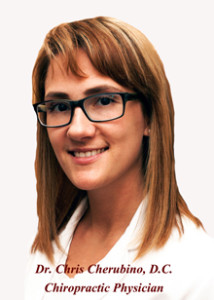Dr. Ron’s Favorite Raw Carrot Juice Recipe by Dr. Ron Cherubino
Tight Muscles are Weak Muscles
Tight Muscles are Weak Muscles
by Dr. Chris Cherubino
Three mornings a week I train in Worcester (at a really awesome place called Worcester Kettlebell Club, which you should all check out.) During each of these training sessions, I begin by doing some corrective movements, which were picked for me specifically. These could be divided into two categories: stretching and stabilization. This morning, I started thinking about an adage that I have carried with me since I began practicing. “A spasming muscle is a weak muscle.”
When a patient comes into the office and tells me they have tight muscles, I immediately start questioning them about exercise. Most people avoid exercising areas that are contracted because it can be painful. This type of pain, however, is more often an indication of compensation than of pathology.
Physiology of Tight Muscles
Before we can understand why weak muscles spasm we have to look at our bodies as a whole. We have an incredible ability to survive. In the case of weight-bearing, “survival” consists of staying upright and completing our activities of daily living. It does not necessarily mean doing these things without pain. The body’s only priority is completing tasks and it will go to great lengths to let us do things we need to do.
So now let’s take the example of a person with a spasmed/highly contracted rhomboid. The rhomboids are bilateral muscles that allow us to retract our scapulae. Basically, they help us to pull things back toward us that we have reached for with our arms. They tend to be weak muscles in most people. So let’s pretend you’re a person who has a poorly trained rhomboid on the right. You are also right-handed for the sake of this story and you work at desk. 90% of the time, when you reach for your mouse or your coffee or a pencil, you do it with you right hand. Your rhomboid activates every single time you do this.
By the time it’s 1pm, your neck and shoulder are starting to hurt and your rhomboid feels “tight.” You decide to stretch that area. You get relief for about five minutes before your tight muscles come back. This is what lands you in my office. As you’re explaining to me how you have such tight muscles, I start asking you what exercises you do for that area. You say “well, it’s already so tight; I try to stretch it.”
That’s the mistake. Your body, in its infinite wisdom, tried to get you through the day and keep your arm attached while you repetitively reached forward. It didn’t have the strength to do it properly, so it fixed your scapula in place to add stability to your shoulder joint and prevent injury. You can stretch and have adjustments and work on the soft tissue until the cows come home, but the only thing that will ultimately fix those tight muscles is strengthening the rhomboid until it is strong enough to live up to the expectations you place on it during your everyday life.
Targeted Training for Weak Muscles
This is why having a targeted training program that addresses your intrinsic stability muscles is so important. These exercises would be those that use the tight muscles as stabilizers, not as prime movers. An example for the rhomboids would be anything that requires holding weight overhead. To do this activity without dropping the weight, the rhomboids have to contract and will eventually gain strength, but without the pain that would be associated with working on them directly. As we do complex movements that recruit stabilizers we develop the ability to be resilient in situations that tax specific weak muscles and can perform our regular activities with more ease and less pain.
If you’re confused about exercise contact me at the office and I will get you started on the right path.
 Dr. Chris Cherubino is a chiropractic physician on staff at Cherubino Health Center, which is located just outside of Boston, Massachusetts. She is an advocate for self-directed treatment plans that include patient oriented goals, measurable means of evaluation, and evidence based treatment protocols. If you like this article, be sure to subscribe to receive email updates. (Bottom or side of this page)
Dr. Chris Cherubino is a chiropractic physician on staff at Cherubino Health Center, which is located just outside of Boston, Massachusetts. She is an advocate for self-directed treatment plans that include patient oriented goals, measurable means of evaluation, and evidence based treatment protocols. If you like this article, be sure to subscribe to receive email updates. (Bottom or side of this page)





